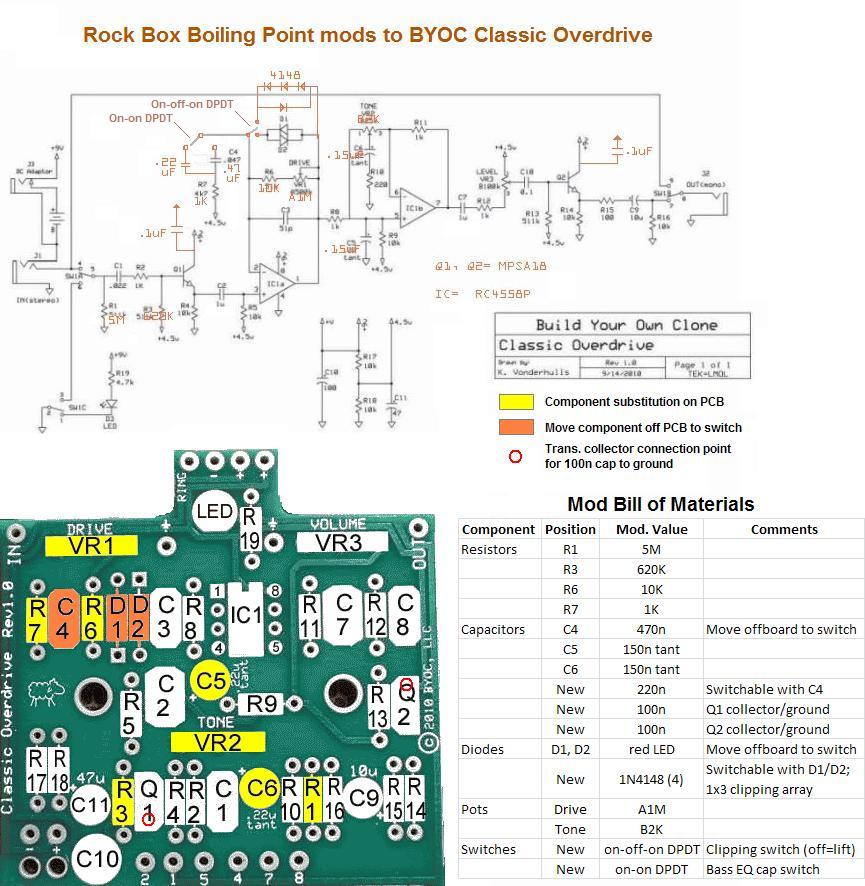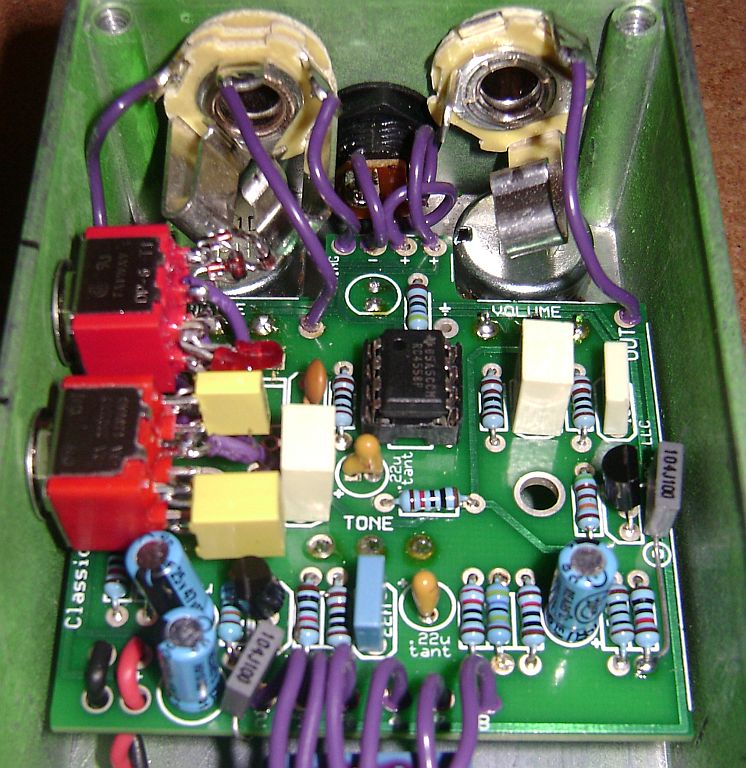I decided to modify my BYOC Classic Overdrive to Rock Box Boiling Point specs, partly out of curiosity about the reputation of this TS mod, and partly to see how easily it could be done, in response to a forum post here. The RBBP is really just a high-gain version of the TS808 circuit, with switchable clipping diodes and a "normal/fat" bass EQ switch. Other than substituting a few components on the PCB, the main modification is the addition of two toggle switches for the clipping and EQ switching. Since I was doing this work on an already completed COD build, I opted to just mount the two switches next to each other on the input jack side of the enclosure. There's sufficient room over the top of the component side of the PCB for two mini-toggles to fit there quite handily. I used DPDT switches for both, soldered the components across the end pairs of lugs, and wired the middle lugs back to the appropriate eyelets on the PCB.
There are also two 100n caps added in mod, running between the collector of each buffer transistor and ground. I just tack-soldered these in place; I used the solder joint for the wire connection for lug 2 of the footswitch as the ground for the input buffer cap, and the bottom eyelet of R14 for the output buffer cap. I'm not completely sure what the function of these two caps is, but I installed them to stay true to the
RBBP schematic.
The modified pedal works as expected, and certainly has plenty of gain on tap. The combination of the 1K resistor at R7 and the A1M drive pot raises the circuit's maximum gain factor from the stock TS value of 118 to 1011, a factor of 8.5 increase. From about 2 o'clock and up on the drive pot, it's really more of a distortion pedal than an overdrive, especially with humbuckers. The 220n setting on the EQ switch gives essentially the same bass response as a stock TS circuit, and the 470n setting fattens it up by dropping the bass rolloff frequency from ~720Hz down to ~340Hz. I find that this value sounds good with single coils but starts getting a bit muddy with humbuckers, especially at higher gain settings. Overall, the modified pedal is quite a bit brighter sounding than my stock COD build was, primarily from dropping the two tantalum cap values down to 150n, I think. The higher input impedance from the R1 & R3 substitutions probably have some effect, as well.
The three clipping switch settings sound pretty much as you would expect, with the 1x3 1N4148 diodes giving the most distortion/compression, the LED's less so and noticeably louder, and the middle "diode lift" setting being loudest and least distorted. Bottom line: a brighter and much gainier overdrive pedal with some nice tonal flexibility from the two toggle switches, but still quite clearly a Tube Screamer in character. I certainly don't find anything novel here, but it does what you would expect it to do well enough. And modding a
$70 COD kit beats the heck out of dropping $350 on a "real" RBBP. But I still think that the
BYOC Overdrive 2 has more to offer, especially with the
before-or-after boost wiring mod.
Below is a composite diagram I put together, using a modified version of
Guitarmageddon's COD schematic mark-up (thanks, mate!!), along with a color-coded COD board diagram and a "bill of materials" for the mod. I'll add a couple of photos of the modified pedal later....

Gut shot showing the various component modifications and the two added toggle switches. Note the two gray box film caps soldered to the buffer transistor collectors on one side, and connected to ground on the other.

Close-up of the two DPDT mini-toggle switches. The bass EQ switch is on the left, with 220n and 470n caps, and the clipping switch is on the right, with a pair of red LEDs and a 1x3 1N4148 diode array.

Shot of the enclosure showing the toggle switch placement.

_________________
“My favorite programming language is SOLDER” - Bob Pease (RIP)
My Website *
My Musical Gear * My DIY Pedals:
Pg.1 -
Pg.2


